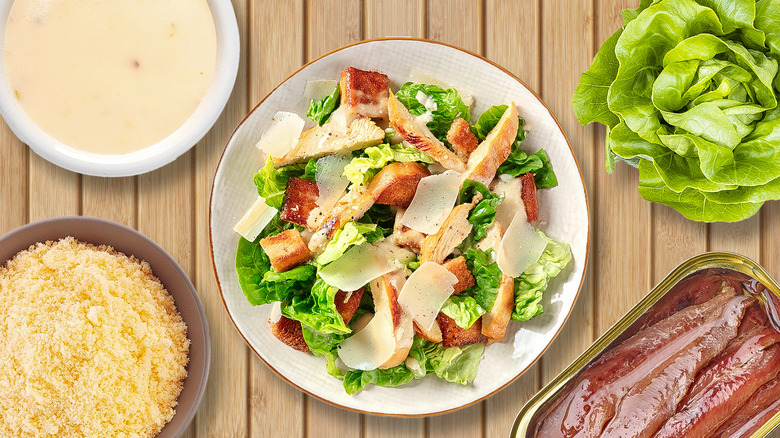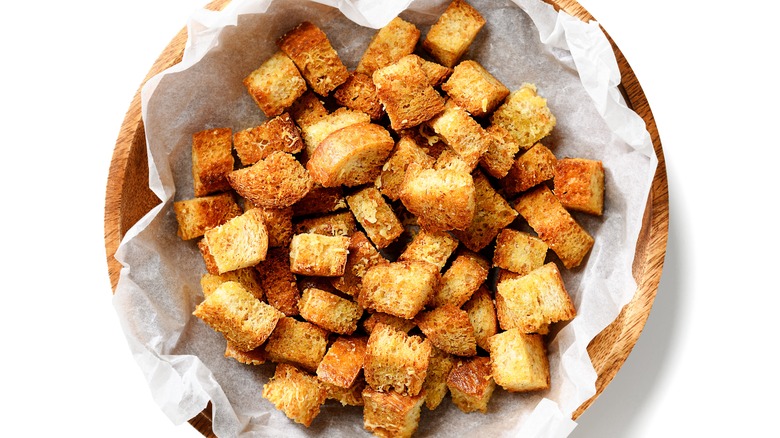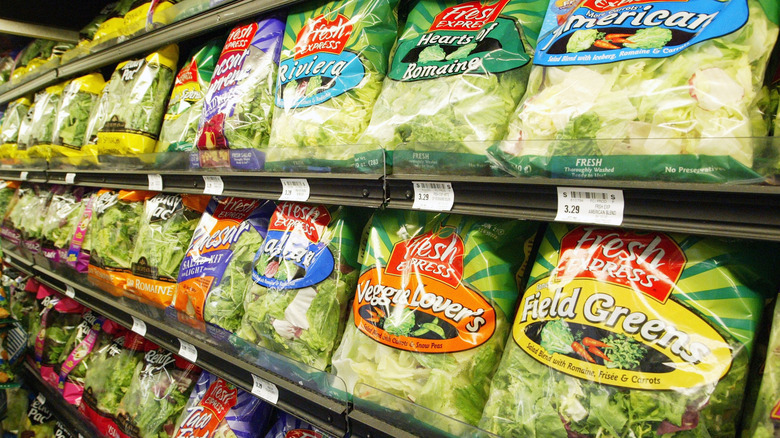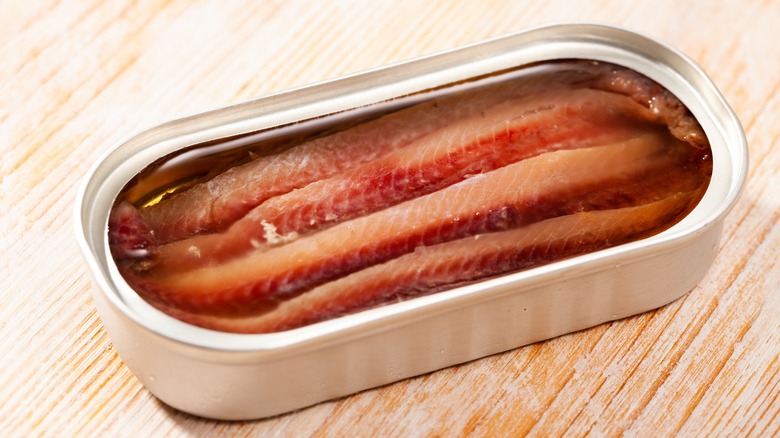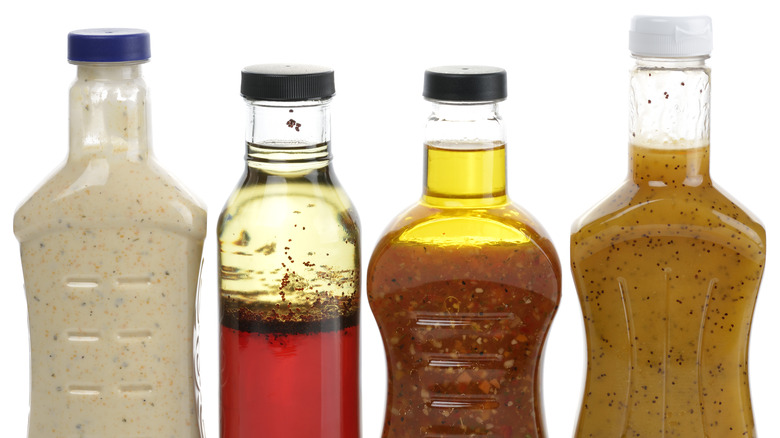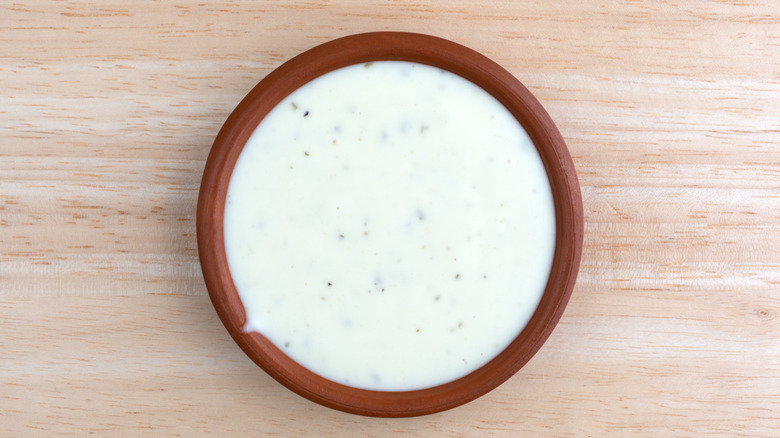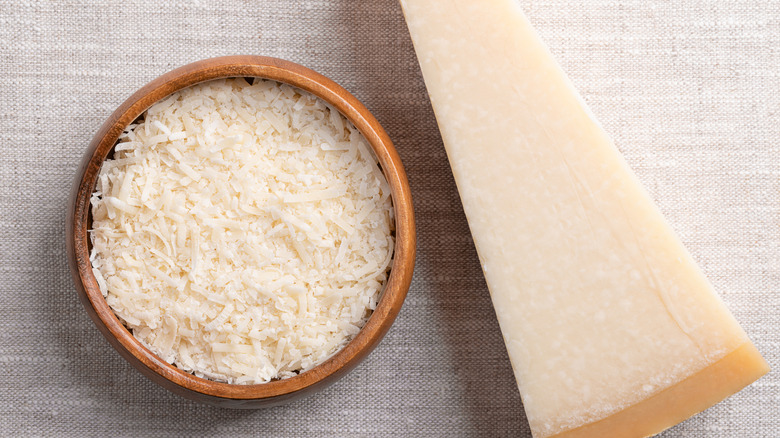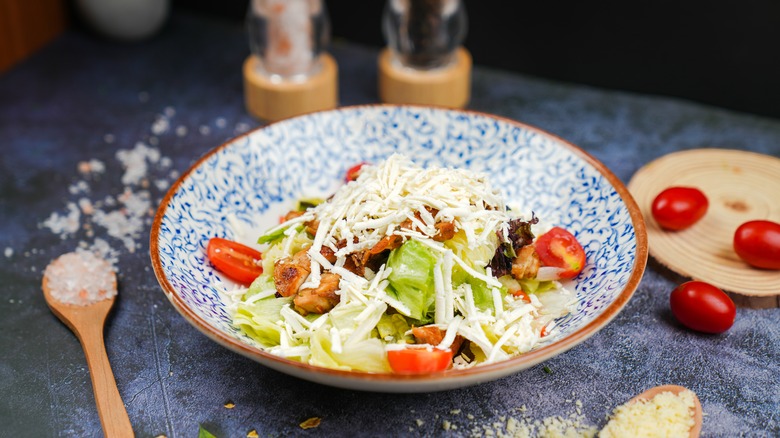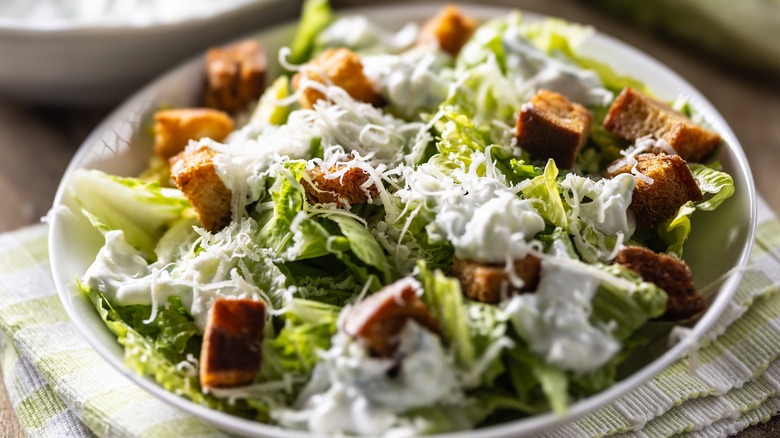13 Mistakes You're Making With Caesar Salad
Salads come in so many different forms, and while there's something to love about all of them, we can't deny that Caesar salad occupies a special place in our hearts. It's everything we've been told a salad isn't: rich, creamy, and decadent. It's the kind of salad you order when you want to indulge, not when you're looking for the healthiest item on the menu. It spits in the face of "healthy" salads everywhere, staking its claim as a delicious, soul-nourishing dish and not just one that functions only as a lighter option on the menu. And how a restaurant prepares a dish as classic as a Caesar salad says a lot about how its other dishes are likely to be presented.
But you don't have to go out to get a good Caesar salad if you know how to make one at home. Unfortunately, though, there are a lot of mistakes you can make with a Caesar salad, simple as it is. We've detailed some of the most common mistakes that home cooks make with this type of salad. By avoiding these mistakes, you can ensure that your Caesar salad tastes as fresh and as delicious as possible. These are the mistakes you might be making with your Caesar salad.
Using anything other than romaine lettuce
We're not usually purists when it comes to most dishes, but Caesar salad may just be an exception. Since it's such a simple recipe, switching out any ingredient — especially the most important one — is going to make a big difference in the finished dish. That's why we cannot abide by including any other greens in a Caesar salad besides romaine, which is what every classic recipe calls for. You may think that iceberg or other types of lettuce will do the trick, but no: It's too watery and lacks the lightly herbal flavor of romaine and offers too much crunch to do the trick.
And don't even get us started on other types of greens. Kale absolutely does not belong in a Caesar salad. Does it pack a lot of nutrition, making for an arguably healthier salad? Sure. But it also has a completely different flavor profile and texture than romaine lettuce, with a bitterness that simply doesn't belong. Spinach is even worse. And arugula? Please, for all that is delicious, no. Stick with the romaine, and you're off to a good start on your salad.
Forgetting to dry your lettuce before adding it to the bowl
There's one step that a lot of home cooks skip when they're making a Caesar salad — or any type of salad, really — and that's drying their greens. It may seem like it's a superfluous step, an extra task that doesn't really need to be done to yield the best possible salad, but that's not actually true. In fact, drying your greens is an incredibly important part of the salad-making process. Why? Well, when your salad greens have water on them, they will repel oil-based dressings, which will lead to a less flavorful bite. Additionally, they can make your salad taste soggy and wilted long before it actually should.
Luckily, though, there are different ways to dry your greens to ensure that they stay crisp and hold onto that dressing as well as they can. A salad spinner will get them dry in a matter of minutes if you happen to have one on hand. Of course, you can always do things the old-fashioned way, with a towel and some time. Either way, drier greens will make for a tastier Caesar salad every time.
Not considering making your own croutons from scratch
Every good salad needs some sort of crunchy element, and although romaine lettuce does have some crunch to it, it's not really enough, if you ask us. That's why most Caesar salad recipes will call for croutons. Of course, you can always buy a bag of pre-made croutons at your local grocery store, but that's not going to yield the freshest flavor. Rather, you're better off making your own croutons from scratch. It's actually a surprisingly simple process, especially if you already have some stale bread on hand. Just tear it into chunks, toss it with some olive oil, salt, and pepper, and throw it into the oven for a few minutes, keeping an eye on it to ensure you get the ideal crispiness.
Not only does this result in a better-tasting salad, but it's also a great way to cut down on your salad-making costs. Plus, if you do have some stale bread on hand, it's a great way to reduce food waste in the process. Once you try making your own croutons, you'll never go back to the bagged, store-bought variety again.
Tearing the romaine instead of chopping it
You might see some advice out there that instructs you to tear greens for your salad instead of chopping them. In a lot of cases, this is good advice, as it makes for a more varied texture and allows the dressing to get into those little nooks and crannies more. But when it comes to a Caesar salad, it generally makes more sense to chop the romaine than it does to tear it. This is because a Caesar salad is mostly lettuce. Therefore, you're going to want easy-to-eat, bite-sized pieces of lettuce to create a more uniform texture.
The trick is to cut that romaine into the right-sized pieces. You're not going to want to shred the lettuce, of course, since that will result in a salad that's too dense. On the other hand, it's also important not to make the pieces too big, which can be hard to fit in your mouth. Those bite-sized pieces are exactly what you're going for when you're chopping lettuce for a Caesar salad.
Using precut, bagged lettuce
We all like using kitchen hacks that save us time, but there are some shortcuts you don't want to take. And when it comes to making a Caesar salad, you're generally going to want to avoid using precut, bagged lettuce. Yes, even if it's romaine. First of all, you're rarely getting lettuce that's as fresh as you want it to be when you use the bagged variety, and since that's the star of the show in this recipe, that lack of freshness is to be avoided at all costs. Plus, you don't have control over cutting each individual piece to your preferred size. And the last thing you want is a salad with sad, wilted lettuce that's hard to eat because the pieces are too big.
Apart from freshness, chopping up your own romaine lettuce is cheaper than buying the precut variety. So, yes, you'll have to do a bit of extra work, but that work may all be worth it in the end when you get to eat a fresher, tastier salad after it's all said and done.
Skipping the anchovies
To some people, the word "anchovies" elicits an immediate nose wrinkle. There are some who claim not to like the tiny, salty fish that give Caesar salad its signature flavor, but hear us out: They're actually an important part of the recipe. You're going to use very basic seasonings for this salad — salt and pepper are really all you need. Therefore, you need to capture the complexity the dish needs in other ways. Anchovies make that happen. Not only are they salty, but they also pack an umami punch that keeps things tasting as interesting as possible. Ever wonder why the Caesar salad you eat at restaurants tastes so much better than the ones you make at home? It may be because you're not including anchovies in the mix.
Just because you don't like the way these tiny fish taste all on their own doesn't mean you shouldn't include them in your salad. Once you break them up and combine them with the rest of the dressing ingredients, you won't even be able to tell they're there at all. And when you realize just how much flavor they can add to a dish as simple as Caesar salad, you may just want to use them in other dishes as well.
Utilizing bottled dressing instead of making it from scratch
Can you buy bottled Caesar dressing at the grocery store? Sure. But should you? If you ask us, absolutely not. First of all, this kind of salad is all about freshness. The lettuce should be nice and crisp, of course, and the dressing should be similarly fresh. Mixing all of the ingredients by hand is a bit of extra work, of course, but it's going to get you a better-tasting salad. Plus, making your salad this way guarantees that you'll be able to adjust the dressing to your personal taste preferences. If you're not a huge fan of super garlicky dressings, then go easy on the garlic. If you really like the umami intensity of anchovies, you can add a few extra to the mix. It's all in your hands.
Bottled dressing can come in handy at times, and if you're really pinched for time or can't make dressing from scratch for whatever reason, then it might have to do. But when you're trying to make an especially delicious Caesar salad, it pays off to make everything — including the dressing — from scratch.
Thinking you can use ranch dressing instead of Caesar
Using bottled dressing isn't ideal, of course, but there's a bigger season salad sin you can commit when it comes to the dressing: using ranch instead of Caesar. Yes, we know that the two dressings look somewhat similar, both being creamy and white. But believe us when we say that these two dressings are absolutely not the same thing and can not be used interchangeably. Mayonnaise and sour cream make up the base of ranch dressing, which is then enhanced by various herbs.
Caesar dressing also contains mayonnaise, but that's basically where the similarities end. Olive oil, lemon juice, Dijon mustard, and anchovies are at the heart of a good Caesar dressing, the flavors of which just can't be replaced by ranch. Ranch dressing has its place in a variety of recipes, but it absolutely does not belong on your Caesar salad. Once it touches your lettuce, you're working with a completely different salad altogether.
Using any cheese other than Parmesan
If you ask us, the absolute best part of a Caesar salad is the cheese. The best Caesars do not go light on the cheese at all. In fact, they're piled high with the stuff, almost making the lettuce itself an accessory to the cheese. If you're a real cheese lover, you may assume that any type of cheese will do here, but let's get one thing straight: Only Parmesan cheese belongs on a Caesar salad.
First of all, there's the matter of texture. Parmesan, as a harder cheese, can either be grated to yield really tiny, fluffy pieces of cheese or shaved to give you bigger chunks of cheese. Either way is fine, but only a hard cheese like Parmesan can achieve these types of textures. It's also about the flavor, though — Parmesan cheese is known for its umami flavor, which works to complement the other umami notes that are already in the dish before cheese even comes into the picture. Luckily, it's easy to find Parmesan cheese at just about any grocery store or cheese monger, so it shouldn't be hard to source this topping for your salad.
Choosing pre-grated Parmesan instead of doing it yourself
There are times when we all want to take shortcuts in the kitchen. Maybe you've had a particularly busy day at work and just want to get dinner on the table as quickly as possible, or maybe you're running behind schedule for the dinner party you planned. Either way, there are some shortcuts that really can cut down on your prep time and still yield delicious results. However, using pre-grated Parmesan is not one of them, since it'll really alter the quality of your meal.
You shouldn't use pre-grated Parmesan for your Caesar salad (or basically any other dish, for that matter) because it's often not real Parmesan at all. Instead, they can be knockoff products that are produced in the United States but do not have the same flavor as actual Parmesan. Plus, these types of cheese often contain anti-caking additives, which you definitely don't need to include in your salad. And although, yes, grating your own cheese takes some extra time, it also allows you to control the texture of the cheese instead of having to settle for those unappetizing little matchstick-shaped pieces of Parmesan.
Adding extra, unnecessary ingredients
Again, we're not always purists when it comes to specific dishes, but a classic, traditional Caesar salad is something that should be respected and kept intact — not altered with a bunch of added ingredients that don't belong. We love adding a slew of vegetables to other salads, especially when we're just using up what we already have in our fridges, but that's not a good plan of attack when you're making a Caesar salad. Apart from the lettuce itself, you don't need to add any other vegetables. Tomatoes are an absolute no. Their sweetness and juiciness just don't belong in this creamy salad. Cucumbers? Add them and we'll literally weep tears of genuine sorrow. The same idea applies to any other vegetable.
You can keep it simple when it comes to seasonings as well. Salt and pepper are all you really need — make sure you add them to both the salad itself as well as the dressing. Don't muddle up the salad with any additional seasonings, since those simple spices are all you really need.
Preparing the salad long before you're ready to serve it
Most of us crave a salad when we want something that tastes super fresh and crunchy, so if you get a plate of greens that looks sad and wilted, you're probably going to be disappointed. That's exactly why you shouldn't prepare your Caesar salad too far in advance of the time you're serving it. Sure, when you're making dinner, it's always nice to get easier tasks out of the way as soon as possible. But if you're serving Caesar salad, it's one of the dishes you'll want to prepare last.
A good Caesar salad features lettuce that's been tossed with homemade dressing. However, dressed salad tends to wilt quickly if it's not eaten within a short amount of time, so you won't want to keep a dressed Caesar salad out on the counter for too long before serving it. Plus, serving the dry greens on their own and then having everyone individually add the dressing onto their own salad doesn't allow that dressing to coat the lettuce as well as it should. Therefore, it only makes sense to prepare the dressing and the salad together, then serve shortly thereafter.
Going too heavy on the dressing
Without the dressing, Caesar salad is really just some chopped lettuce and croutons in a bowl. The dressing may just be the most important component of this type of salad. But that doesn't mean you can't go overboard with said dressing. Since Caesar dressing is so rich and creamy, it can quickly overpower an ingredient as light, fresh, and neutral-tasting as romaine lettuce. Therefore, you'll want to avoid making too much dressing before tossing it with the lettuce.
Your best bet is to simply follow the ratios in your favorite Caesar salad recipe, but you can always just eye it if you don't want to get out your measuring spoons. Just remember that you can always remove some of the dressing from the bowl before adding the lettuce in if you think it might be too much. Then, if you'd like to add more afterward, you can. Make sure that every piece of lettuce is well-coated but not absolutely drenched in dressing.
